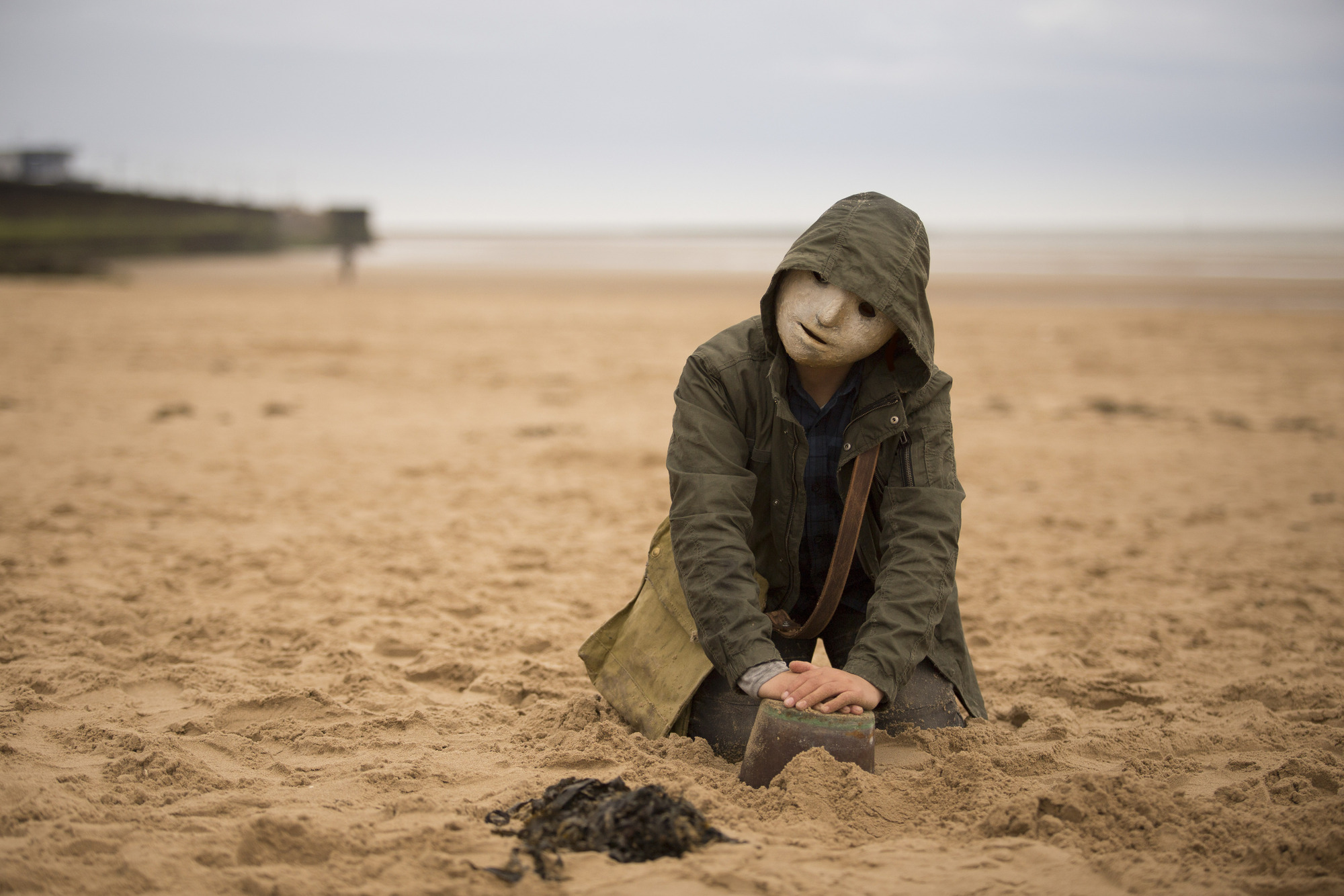“The family who lose their mouths in The Twilight Zone.”
“Oh! The candy-striper vampire one in Are You Afraid Of The Dark? And the clown, The Ghastly Grinner!”
“The magician one in Amazing Stories. Definitely.”
“There’s one about a pool and this horrible, fleshy skeleton came out of it and grabbed these kids. Still now, if you Google it, it’s one of the most horrifying things I’ve ever seen, I can’t believe it was ever on telly.”
“The Never-Ending Story had something called The Nothing, that was really nothing, literally and figuratively. It stuck with me and freaked me out as a kid, the idea that things were disappearing and nothing was in its place.”
Bede Blake and Robert Butler, the writer-creators of new CBBC half-hour anthology series Creeped Out, are swapping memories of TV and film that left an indelible mark on them as children. “Probably for good reason, kids don’t get that stuff anymore but sort of not, actually,” says Bede.
“I think it’s a tragedy,” says Robert, “those shows were were just about on the line of terrifying you and inspiring you and enchanting you.” Bede agrees, “They didn’t damage you, quite the opposite, they fired your imagination.”
“Isn’t it funny,” Bede continues, “how certain shows from your youth stay with you your entire life? That creature on the wing of the plane in The Twilight Zone, that can stick with you and be with you twenty, thirty years later. That’s what we wanted to do for a generation of young people, to have memories of certain episodes or stories, twenty years later, still be in their head.”
That’s sure to be the case with Creeped Out, the first episode of which airs today on CBBC. I’m a grown-up with a mortgage and sciatica, and I haven’t been able to shake the stories yet. Not that they’re traumatising (there’s nothing so far that children wouldn’t come across in an episode of Doctor Who); they’re well-plotted with characters you quickly come to care about. And without being at all po-faced or didactic, they’re also satisfyingly sincere.
“Things like Are You Afraid of the Dark? Goosebumps, Eerie Indiana, Round The Twist, all those shows,” Robert says, “took themselves very seriously, which was really exciting. There was no winking at the audience, you weren’t dragged out of it, you were in that moment. That’s something else that you don’t get a lot of on kids’ TV now. It’s often a bit shiny or a bit happy. I think kids want this stuff, the more you treat them with respect and don’t talk down to them, the happier they are.”
One of the aims with Creeped Out, Bede and Robert explain, is to get its young audience talking. I think kids will talk about these stories, I tell them. They’ll talk about them in playgrounds and online and decades later, in pubs, having conversations just like this one. ‘Do you remember the one about the sinister old lady neighbour?’ one Creeped Out fan might say in the future. ‘What about the one with the evil phone! And Mr Blackteeth! Still makes me shiver to think of him’.
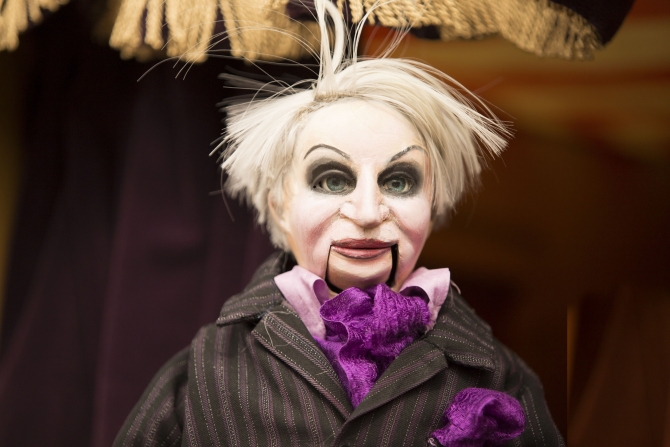
Mr Blackteeth is the eerie Punch & Judy Show puppet in Slapstick, the first instalment in this thirteen-part anthology. Starring Wolfblood’s Sydney Wade, it’s a beautifully compact story with a clear lesson, but also a morally tricky resolution.
“Some of the episodes have a happy ending,” says Bede, “but some don’t. They have ambiguous or twist endings, or endings you don’t expect. I think CBBC is being really brave with it in terms of allowing stories to go where they go rather than forcing a happy ending. We certainly believe in the audience’s appetite for a good story rather than being spoon-fed a bad story that ties up in a neat bow. You don’t necessarily talk about episodes that are tied up neatly, but you really talk about episodes that end like some of these do.”
There’s an ambition for co-viewing with Creeped Out, says Bede. “We had this idea that if a child is watching it and a parent walks past then they would be hooked into it too.”
One element designed to provoke speculation and conversation is Creeped Out’s framework character The Curious. “They say he collects strange tales,” run the opening lines of each week;s story, “and if you ever hear his whistle, you know something creepy is about to unfold…”
“We’d always wanted a very tight sort of Rod Serling intro that got you into the story then you were away, who then came back at the end for a little tease. That’s where The Curious came from,” explains Robert. “Originally when we pitched it”, he continues, “The Curious wasn’t part of it, it was more of a Breakfast Club-style group of kids that stumble upon a book in a museum. Then that just didn’t feel as fresh and was starting to distract from the actual stories themselves. We never like to say whether it’s a boy or a girl or a demon or a ghost, we just envisaged The Curious and that’s why that name stuck. Whatever it is, it’s The Curious story-collector!”
“It’s designed to be an evolving urban legend, says Bede. “You don’t know what’s under that mask, that goes back to what we were saying about getting kids talking and speculating about what it could be. Story-wise, he’s not a threat to the children. He has his name because he is naturally curious. He’s not somebody out to do harm. He’s an observer.”
How does the show approach writing horror for a young audience? “As long as stories are coming from the right place,” says Robert, “you can get away with a lot. The trouble you run into is if you’re deliberately setting out to upset or scare or freak people out. We’re not. We always approach it from ‘what is the heart of this story?’ then it’s ‘what can we do to add that Creeped Out element?”
Eerie stories for children can sometimes fail, says Bede, if they’re approached solely in terms of shocks. “If you’re not telling a good story or an interesting story or a story about a character that you care about, then jump-scares don’t really add up to much. We didn’t approach it simplistically in terms of freaking the audience out. We always wanted to push it as far as we can go within the boundaries of not wanting to put kids into therapy!” he laughs.
“Beyond wanting to protect the audience, the ambition was to be as brave as possible,” says Robert. Both CBBC and DHX, the Canadian network that co-produces the show, gave the creators a long leash and “freedom to pitch whatever the hell we liked,” but also provided buffers and steering when required.
“It was always surprising,” Bede says. “Things that you’d considered minor were a problem and things you’d considered major were not going to be a problem.” One story involved a child falling into a swimming pool, which required delicate handling. “You can only show so much with a child going into a pool,” he says.
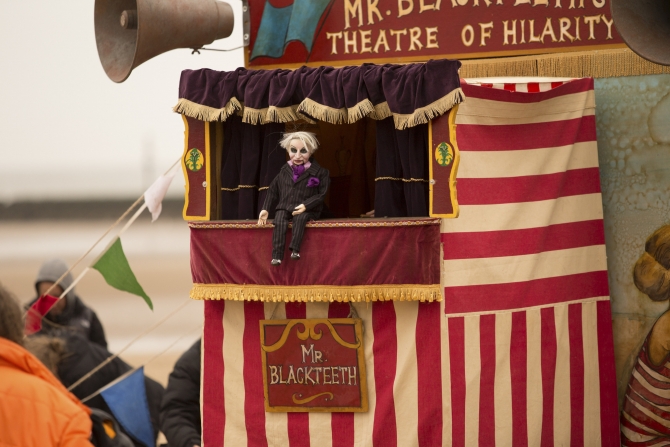
“We’ve got an episode about an ear worm,” says Robert, “that pays homage to the worm scene in Star Trek: Wrath Of Khan. A creature gets in the ear and turns these girl guides into sort of zombie-type characters. Weirdly, we were okay with the zombies, but the biggest worry was that kids are apparently terrified of actual creepy crawlies going near their faces so we had to make sure that it didn’t look anything like a worm, more like an alien-type creature. That was a weird one, we could have all these creatures, but we couldn’t have an earthworm!”
“It’s this tug of war between good drama and being responsible,” Bede concludes.
On the subject of responsibility, the episodes available for preview all share a fable-style moral. Was that a goal with this series? “We certainly didn’t set out to do that,” says Bede. “Fables that have an impact culturally often relate back to moral dilemmas, don’t they? That’s as true for kids as it is for grown-ups. It’s always a rich source of storytelling to have a moral or ethical dilemma at the centre.”
“For us, it was about finding what’s an interesting arc for the characters,” adds Robert. “A lot of the time, those fables or morals fitted quite nicely. But we never thought, ‘how can we preach to kids?’ That was never the intention. We’ve got an episode about an internet troll who starts to become an actual troll, which is very simple to pitch, then you have to find out how that all works. It’s about finding an interesting character and asking what is their flaw then seeing how that plays out among the supernatural elements.”
Some of the stories, like all the best sci-fi and fantasy, could be seen as depicting real-life concerns disguised by those supernatural elements. Marti, an episode about a girl whose smartphone becomes increasingly central in her life, could be an allegory for the dangers of a coercive, controlling relationship as much as a warning about the risks of being in thrall to technology, I suggest. “A lot of those things happened naturally,” says Bede. “If you’re representing kids in an honest way, these things are going to come through on their own.”
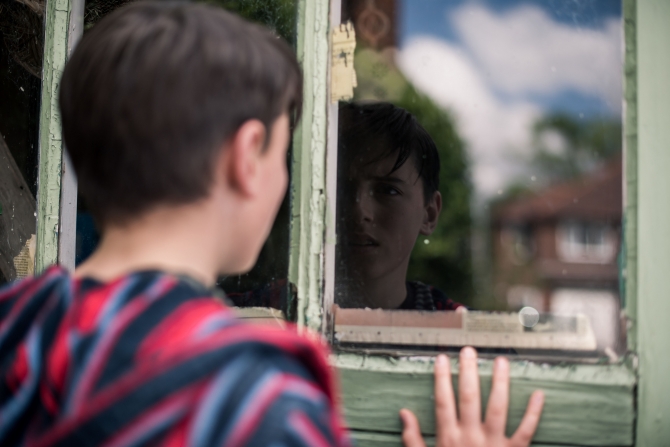
“With Marti, we could have just gone down the route of this phone being just annoying,” says Robert, “but if you dig at that, technology can be quite dangerous and end up affecting our lives and our relationships, so once you give it that extra element, you can get something really special out of it. If you can put in a serious story, with the bullying in Troll or the control in Marti, adding that extra layer of seriousness gives it more weight. Kids really react to that sort of stuff, when they know they’re being taken seriously.”
As a format, anthologies are currently enjoying a resurgence on screen. In addition to Black Mirror and Inside No. 9, there’s Electric Dreams, Dimension 404, Channel Zero… When the idea for Creeped Out was first conceived four years ago though, that wasn’t the case. “We had some convincing to do, let’s put it that way,” laughs Bede, “about whether an anthology show can work without recurring characters, which is the natural worry of the broadcaster.”
“I’m quite surprised that [anthology drama] is getting a resurgence,” says Robert, “because they are really hard to do. The fact that there’s other anthologies out there doing it really well, you’ve really got to applaud them for even getting on telly, let alone making them amazing. Inside No. 9 is a masterpiece. I’ve rewatched every episode countless times, it’s genius.”
If everything goes to plan and a second series is commissioned, in fact, Bede and Robert would love to invite a broader spread of writers and directors to take part, Inside No. 9’s Reece Shearsmith and Steve Pemberton chief among them.
“We love Black Mirror, and Inside No. 9 in particular,” says Bede. “That’s a future ambition, to get [Shearsmith and Pemberton] to come and do a kids’ version of what they do on their show. Once we’ve gained a bit of traction, an ambition is to get bigger names to come in and tell a one-off story, which could be very attractive because a lot of these people are doing it for an adult audience, but for a younger audience there aren’t necessarily opportunities to tell these weird tales.”
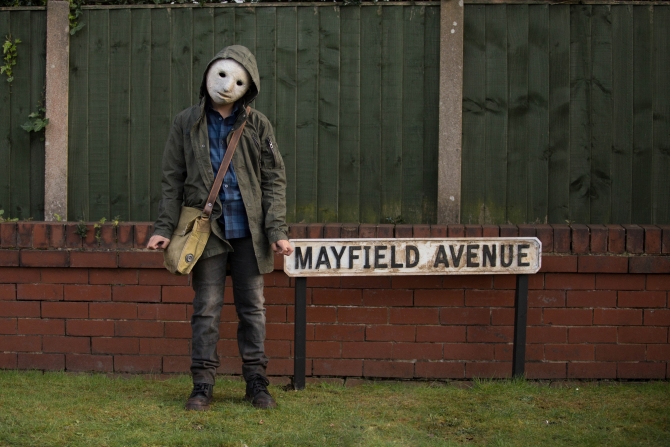
Delighted to work with directors Steve Hughes and Pontypool director Bruce Macdonald (“one of the coolest men we ever met”) on series one, their blow-out wish-list of future collaborators includes the likes of Joe Dante (“that would be insane”), James Wan, Joe Cornish, Edgar Wright, Ben Wheatley… “There’s a ridiculous wish-list”, says Bede. “A lot of these guys and girls don’t make shows that are suitable for their own children, so maybe they’d relish the opportunity to make something their kids can watch.”
“Our dream for this show, when we first started it,” explains Rob, “was to have an episode set in a different country written by a different writer from a different part of the world, telling their own urban myths. We’d love a Japanese story. We’d love a Mexican story. We’d love a Scottish Highlands one. That was our dream.”
A globe-trotting Twilight Zone for kids is a TV concept brimming with geek appeal. Especially considering that though each story is standalone, give or take the odd two-parter, Creeped Out is designed as a shared universe. “You’ll hear character names pop up that cross-populate the world,” says Bede. “There’s an episode called Kindlesticks in which one of the characters in Canada is texting someone in England from an episode called Slapstick. Hopefully it’ll be one of those moments that, if you know the show, you’ll think ‘they’re all linked!’”
Look out for plenty of movie references and Easter Eggs too. Which 1989 Joe Dante film gets a nod in the street name of episode Cat Food? And in the Ear Worm episode, listen out for a quote from a certain 1980s time-travel classic.
Not all of Creeped Out’s Easter Eggs are movie-related. The name of the school in Marti is Denis McGrath High, a touching tribute to a series one writer who sadly passed away during production. “That was a little homage to Denis,” explains Bede, “a dedication to make him part of the legacy of this world.”
“We got the blessing from his family,” says Robert, “we said we’d really like to name a school after him in another episode if that’s okay and they were very happy with that.”
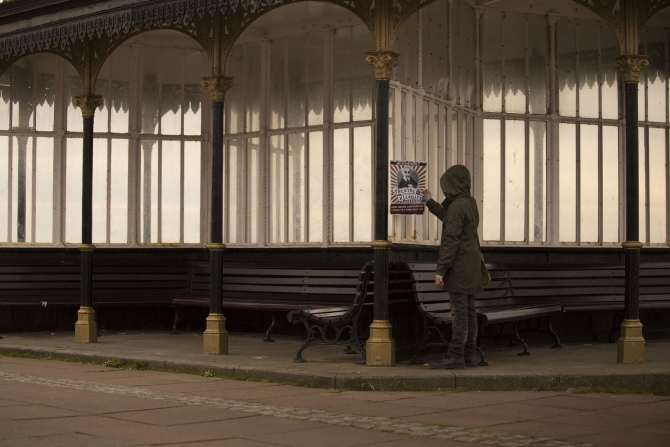
The writer-producers received their own blessing of sorts from an unexpected source during filming. “A big inspiration for this was Spielberg in general and Amazing Stories in particular,” says Bede. One Amazing Stories episode in particular is a real favourite of the pair, who had a happenstance encounter in Canada with one of its stars.
“When we were filming in Toronto,” Robert tells me, “we were waiting for some food and saw this old guy sat at the bar. As we approached him, we realised it was Christopher Lloyd! Which was insane, because Amazing Stories and in particular, Go To The Head Of The Class, one of the famous episodes with him in it, was something we constantly talk about when we were coming up with this show.
“We were the only three people in this bar and we waited for half an hour for him to finish his noodles and were plucking up the courage to say something to him, and I finally said ‘Excuse me, are you Christopher Lloyd?’ and he said yes and clearly didn’t want to be bothered by a couple of idiots, so we made it very quick. You could see him glossing over a bit when Back To The Future came up so I thought, I’ve got to try a bit harder and I said “Amazing Stories is one of our favourite shows and it’s inspired the show we’re making, especially Go To The Head Of The Class” and there was actually a sparkle in the eye!
“He obviously doesn’t hear that every single day but he got a little bit interested and we said we wouldn’t disturb him anymore and shook his hand and he said “good luck with that show” and we went off to get our noodles.”
It must have felt like a benediction from an elder! “It did,” says Rob. “We’re still buzzing off that now. It felt really weird that happened. That is one of the series and episodes that massively inspired this. So if he ever reads this, we’re not crazy, we really do have a show!”
Creeped Out starts tonight, Tuesday the 31st of Halloween, at 7pm on CBBC, and continues weekly thereafter.

